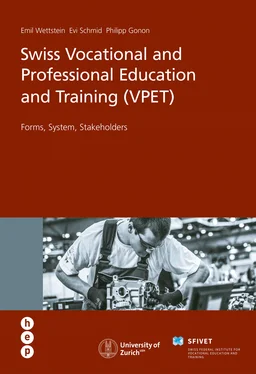1 ...6 7 8 10 11 12 ...18 The 12 August 2013 was a special day in the life of Claudia Juon. For three years, the 19-year-old had attended the Informatikmittelschule (IMS) Frauenfeld (Frauenfeld Information Technology School) and had to deal with classmates and teachers. But now, the fourth year of her training had begun, the traineeship at the company Bühler in Uzwil. Open-plan office, real orders, new reference persons – “I was nervous because I did not know how useful the knowledge from the IT school would be,” recalls Claudia Juon. After two weeks the uncertainty had gone: “I had to continue learning, the programming language alone was different at Bühler.” But the prospective IT technician specialising in applications development had the tools to cope.
Learning contents at the IT school comprise general education subjects and a focus on “Information Technology” and “Economy and Law”. The vocational instruction is geared towards the training plan of the VET programme for the specialisation in applications development and leads to the Federal VET Diploma (EFZ). It is divided into 29 modules. Here, school does not only mean theory, it also means practical experience. Claudia Juon explains: “Around half of the modules were more theoretical, usually chalk and talk. The other half consisted of exercises, group work or projects.” The results of this work were, for example, a website of her own or a reprogrammed calculator. Each module is completed with a competence record consisting of semester grades and a written exam or a project assignment at the end of the module.
Claudia Juon has completed the school-based part of her training. For the Federal VET Diploma she now needs the “individual practical project” (individuelle praktische Arbeit, IPA), while completion of the Federal Vocational Baccalaureate requires an “interdisciplinary project” (interdisziplinäre Projektarbeit). Claudia Juon will tackle both projects during her traineeship, she even has company time available for this, two weeks for each project according to the traineeship contract. This contract also contains information on holidays and the wage, which is generally at the level of a learner in the fourth apprenticeship year. It has to be checked by the IT school and must be approved by the cantonal VET office.
Claudia Juon had to find her traineeship herself, but this was easy for her – “an advantage of being a woman,” she says, smiling. If the search is going slowly, the head of department at the IT school in Frauenfeld, Walter Schnyder, helps out. He says that around half of the traineeship positions are at companies which do not offer dual-track training places. The only requirement for the training is that a programmer has to be part of the team at the company. Until around five years ago, this led to a loss of quality, as Walter Schnyder admits: “At the time, we were glad about every company that offered a traineeship position.” Today, the learners can usually choose between several options.
Claudia Juon has been working at Bühler for a month, supervised by one of the practical trainers who are also responsible for the learners in a dual-track VET programme at the company. At the moment, she is using instructions to install the PCs of external clients, which she then checks and makes ready for delivery. She also helps with the migration of old data to a new version of the department’s project database; she is writing small programs for this, too. And finally she reads the IT books which her specialist supervisor recommends. “For all of this work there is no training plan,” explains Walter Schnyder, “but the companies have to provide evidence that the learners have the opportunity to program during a large part of the traineeship – and are therefore given the foundations for the individual practical project.”
From the perspective of the company Bühler, 42 traineeship weeks is rather short to achieve the training goals, become integrated in the team and become familiar with the company and its culture. Which is why it favours the dual-track training form. Claudia Juon herself would, nevertheless, choose the IT school again. She thinks attending school and subsequently joining the company makes sense and she considers the two of equal value. Laughing, she admits that the twelve weeks of holidays during IT school proved to be no disadvantage.
1.5 VET in a public trade school
Public trade schools are full-time vocational schools which provide entire VET programmes, i.e. both work-based training and classroom instruction. They offer classrooms and workshops and can, therefore, teach theory and practice seamlessly. The public trade schools are largely financed by public funds. Many of them make products which are sold on the market and whose proceeds cover a small part of the costs. In the Federal Vocational and Professional Education and Training Act, they are counted among the “school-based VET programmes” (cf. Chapter 1.4, p. 32).
1.5.1 Emergence of public trade schools in many occupations
Back in the 18th and 19th century, municipalities, associations and also the state founded publicly organised trade schools which guaranteed complete training, in particular in the watchmaking industry (Fallet & Simonin, 2010).
In Switzerland, training programmes for certain professions with high theoretical, technical and also practical requirements are often such full-time school-based programmes (cf. portrait of Maybe Simons, p. 42). In addition to the watchmaking schools mentioned above, which can look back on a long tradition, there are also commercial, crafts and trade and even agricultural establishments of this type in Switzerland. Likewise, there are many specific training programmes and handcraft-related training establishments organised in this way, for example the traditional workshops for dressmakers and the current Bespoke Tailors, Federal VET Diploma (Bekleidungsgestalter/innen EFZ) or the Schule für Holzbildhauerei (Woodcarving School) in Brienz.
1.5.2 Funding of public trade schools
Trade schools, like most school-based training programmes – with the exception of private professional schools – are largely financed from public funds, with money provided by the Confederation, cantons and municipalities. Only a small part of the costs is covered by sales of products made in the public trade school, although there are big differences here depending on the type. In some cases, the learners conclude an apprenticeship contract with the trade school and also receive a wage from the school, in other cases they receive only an allowance or even pay school fees. Accordingly, they are referred to as either learners or students.
1.5.3 Reasons for creating public trade schools
The main motives for establishing public trade schools in the 19th and also later in the 20th century can be identified as follows:
•promoting industrial development,
•developing an elite among professionals,
•maintaining the competitiveness of the trade,
•fostering local commercial/industrial production,
•reducing the shortage of qualified employees in particularly in-demand professions where there are hardly any training positions offered,
•guaranteeing training options in cost-intensive VET programmes,
•enabling VET for young people with good school grades who, at the same time, are aiming to obtain the Federal Vocational Baccalaureate,
•providing VET programmes for young people with special needs in training programmes which, for example, lead to a Federal VET Certificate (EBA).
These motives often occur in combination. The objective of developing specialised skilled workers still plays an important role today – especially in the development cooperation in countries which want to launch an industry or aim at promoting professionally qualified entrepreneurship.
Читать дальше












